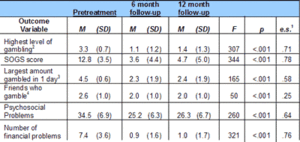There are few scientific studies in the published literature examining treatment outcomes. Even fewer focus on the extended outcome of gambling treatment. The first statewide gambling treatment outcome study, published in 2001 (Stinchfield & Winters), examined the self-reported gambling behavior of former patients at four state-sponsored gambling treatment programs in Minnesota. This week’s WAGER considers the results of this study.
Stinchfield and Winters collected data from 592 (348 male) patients admitted for treatment at one of four Minnesota gambling treatment programs between January 1992 and January 1995. The four treatment programs varied slightly in treatment modality and duration; however, each operated in an outpatient setting and worked toward the main therapeutic goal of abstinence from gambling. Patients completed a multidimensional assessment battery developed by the authors which included modified versions of the South Oaks Gambling Screen (SOGS) (Lesieur & Blume, 1987) and the Client Satisfaction Scale (CSQ) (Larsen, Attkisson, Hargreaves, & Nguyen, 1979), and aspects of gambling and non-gambling behavior. Patients were assessed at admission, discharge, and at six and twelve months after discharge. Significant others also filled out questionnaires as a validity check.
Table 1. Comparison of Pretreatment, 6 Month Follow-up, and 12 Month Follow-up Assessment Stinchfield & Winters, 2001)
1 e.s.= effect size (partial eta)
2 0 = none; 1 = <monthly; 2 = monthly; 3 = weekly; 4 = daily
3 0 = $0; 1 = <$1; 2 = $1-$9; 3 = $10-$99; 4 = $100-$999; 5 = $1,000-$9,999; 6 = $10,000+
4 1 = none; 2 = less than half; 3 = about half; 4 = over half; 5 = all
Using a multivariate analysis of variance (MANOVA) with repeated measures procedure, the authors compared six outcome variables across three follow-up points. Table 1 presents the means (M), and standard deviations (SD) at each observation point, the F statistic of the MANOVA test, and the significance of the differences (p). The results show statistically significant changes from pre to posttreatment for all six variables. The authors noted that while 51% of the sample reported abstinence from gambling during the course of treatment, 28% reported abstinence at the six-month follow-up, and 18% still had not gambled after 12 months. Correcting for non-respondents to follow-up interviews, the authors estimated these figures at 40% and 36%, respectively. Stinchfield and Winters reported that SOGS scores of 5 or higher (indicating probable PG) went from 87% of participants at the time of admission, to 25% at follow-up.
These results bring to light a fundamental question: Is abstinence the only desirable outcome of gambling treatment? While many consider the total post-treatment abstinence rate the ultimate measure of success for a gambling treatment program, the authors noted that this stance ignores the value of comparing patient progress along other dimensions from pre- to post-treatment. Hence, the authors reported that among patients who continued to gamble after completion of the program, 48% showed clinically significant improvement in reducing their gambling frequency, while less than 1% showed deterioration. Interestingly, the study indicated that several (n=17) non-pathological patients were initially enrolled in the program; it is possible that these patients were “pseudoaddicts” (see Zinberg & Lewis, 1964). The authors do not comment on whether these patients completed the program or exhibited signs of progress or deterioration.
While overall these results appear encouraging, the authors discussed limitations of the study including the potential bias due to failure to obtain follow-up data on all respondents. The number of patients that contributed to the information in the table of outcomes above was not provided in the report, but it cannot be more than the 63% followed at 12 months. Only patients who completed treatment were followed so this research could not provide an estimate of the efficacy of the program. The authors noted that the study did not use the experimental research design necessary to make inferences about the impact of treatment.
Despite these concerns, Stinchfield and Winters’ analysis represents an important milestone in the study and treatment of gambling disorders. Because many gambling treatment programs are still in the early phases of development and operation, analysis of statewide or program wide outcome data will be one of the primary factors driving the evolution and advancement of treatment protocols for problem and pathological gambling. Though such studies are now just starting to become available (e.g., Shaffer, LaBrie, LaPlante, Kidman, & Korn, 2002; see WAGER, 7(45)), it is imperative that this type of research be continued and expanded.
Comments on this article can be addressed to Tony Donato.
References
Larsen, D., Attkisson, C., Hargreaves, W., & Nguyen, J. (1979). Assessment of client/patient satisfaction: Development of a general scale. Evaluation and Program Planning, 2, 197-207.
Lesieur, H. R., & Blume, S. B. (1987). The South Oaks Gambling Screen (SOGS): A new instrument for the identification of pathological gamblers. American Journal of Psychiatry, 144(9), 1184-1188.
Shaffer, H. J., LaBrie, R., LaPlante, D., Kidman, R., & Korn, D. A. (2002). Evaluating the Iowa Gambling Treatment Program. Boston: Harvard Medical School, Division on Addictions.
Stinchfield, R., & Winters, K. C. (2001). Outcome of Minnesota’s gambling treatment programs. Journal of Gambling Studies, 17(3), 217-245.
WAGER. (2002). Riches to rags: debt among Iowa Gambling Treatment Program participants. Retrieved January 28, 2003, from the World Wide Web:
Zinberg, N. E., & Lewis, D. C. (1964). Narcotic usage: I. A spectrum of a difficult medical problem. New England Journal of Medicine, 270, 989-993.





